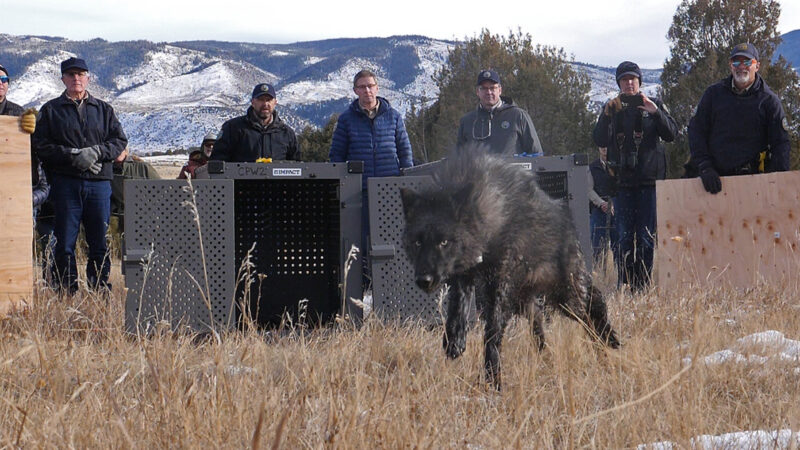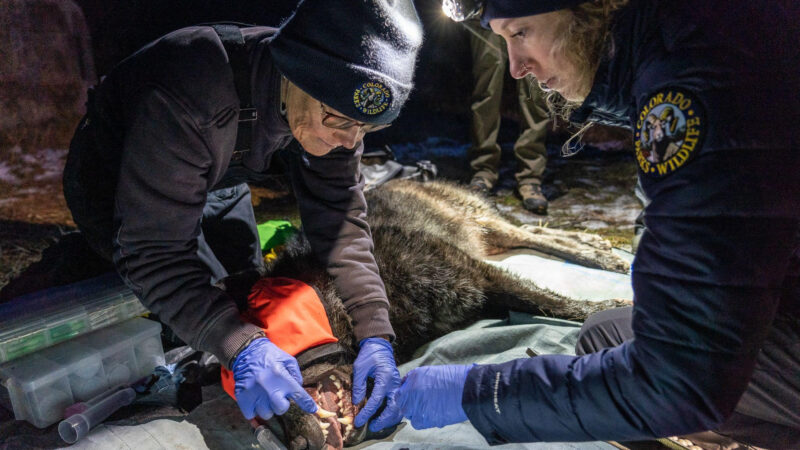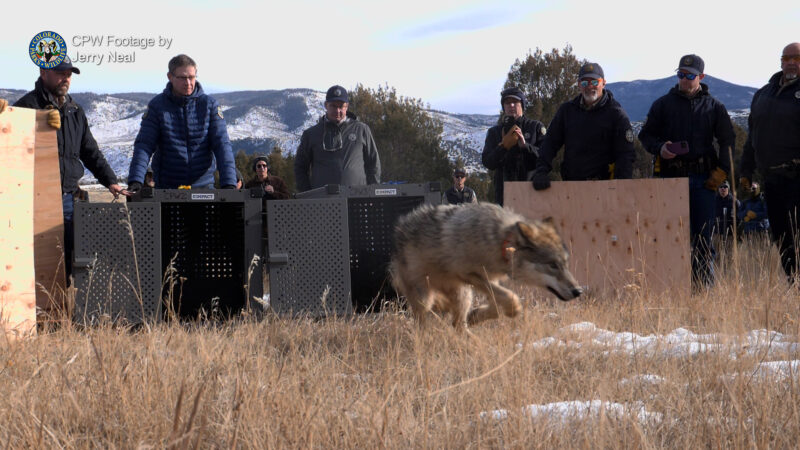Following the lead of other states across the northwest, Colorado launched their wolf re-introduction program this week with the release of 5 gray wolves captured from Oregon. It was a highly controversial move that could have major repercussions as evidenced by states like Montana, Idaho and Wyoming.

A release from the Colorado Parks & Wildlife tells the story – Colorado Parks and Wildlife (CPW) experts released five gray wolves onto public land in Grand County in a historic effort to create a permanent, self-sustaining wolf population and fulfill voter approval to re-establish gray wolves in Colorado.
The gray wolves were captured in Oregon where CPW veterinarians and biologists evaluated them to determine if they were fit for relocation to Colorado. Criteria for release included the age, sex, health and body condition of each animal.
Each gray wolf was weighed and measured. Staff collected genetic material – tissue and blood samples – before fitting each with a GPS satellite collar for tracking upon release by CPW staff. Then, the wolves were given vaccines and were placed in crates and flown to Colorado for release back into the wild.

Meet the Pack
Below you’ll find a quick look at the age, sex, color and weight of the gray wolves released.
2302-OR: Juvenile female, black color, 68 lbs., Five Points Pack
2303-OR: Juvenile male, gray color, 76 lbs. Five Points Pack
2304-OR: Juvenile female, gray color, 76 lbs., Noregaard Pack
2305-OR: Juvenile male, gray color, 93 lbs., Noregaard Pack
2307-OR: Adult male, black color, 108 lbs., Wenaha Pack
All wolves captured, collared and released in Colorado will use the same naming convention: The first two numbers (23) will indicate the year the animal was captured. The second set of numbers informs biologists of the wolf’s gender (males will have odd numbers, females will have even) and the order in which it was collared. *The “OR” suffix indicates the wolves came from Oregon.
CPW will repeat the process until at least 10 – 15 wolves have been reintroduced in Colorado by mid-March 2024. As outlined in the Colorado Wolf Restoration and Management Plan, CPW hopes to release 30 to 50 wolves over the next 3 – 5 years using wolves captured from nearby northern Rockies states from several different packs by trapping and darting them in the winter.
Gray wolves are listed both state and federally as an endangered species in Colorado by the U.S. Fish and Wildlife Service (USFWS). The U.S. Fish and Wildlife Service has designated the Colorado wolf population as Experimental under Section 10(j) of the Endangered Species Act. This provides management flexibility that would otherwise be prohibited.
CPW’s reintroduction program builds on work started by the USFWS in 1995 when that federal agency began restoring gray wolves in the Western U.S., starting with an experimental population released in Yellowstone National Park in Montana. Wolf reintroduction efforts eventually spread to Wyoming, Idaho, New Mexico and Arizona.

The Oregon wolves released represent CPW’s determination to fulfill the wishes of Colorado voters who, in 2020, directed the agency to begin reintroducing wolves by Dec. 31, 2023. The new wolves will be managed by CPW using the Colorado Wolf Restoration and Management Plan, approved by the CPW Commission in May 2023, after more than two years of extensive statewide stakeholder meetings and outreach via a series of public hearings.
Ultimately, CPW plans to recover and maintain a viable, self-sustaining wolf population in Colorado while balancing the need to manage interactions between wolves, people and livestock.
This project marks another milestone in the long CPW tradition of species recovery in Colorado. These include the black-footed ferret, one of North America’s rarest mammals, the 1999 effort to reintroduce the lynx, the Rocky Mountain bighorn sheep, the greenback cutthroat trout, and many more.
“Today, history was made in Colorado. For the first time since the 1940s, the howl of wolves will officially return to western Colorado. The return of wolves fulfills the will of voters who, in 2020, passed an initiative requiring the reintroduction of wolves starting by Dec. 31, 2023.
What followed were three years of comprehensive listening and work by Colorado Parks and Wildlife to draft a plan to restore and manage wolves that included public meetings in every corner of the state and was inclusive of all points of view and weighed the needs of a wide range of communities with a deep interest in the thoughtful outcome of this effort,” said Colorado Governor Jared Polis.
“I am proud of the Colorado Parks and Wildlife staff for their hard work to make this happen. The shared efforts to reintroduce wolves are just getting started and wolves will rejoin a diverse ecosystem of Colorado wildlife.”

 By
By 



